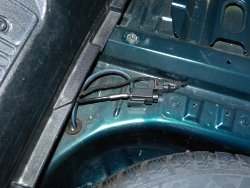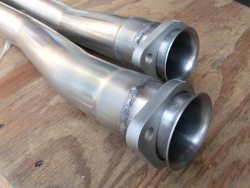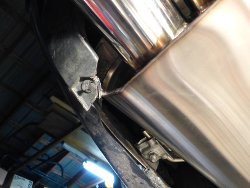Saturday, December 21, 2013
Stromung Exhaust Installed
With sunny skies and temperatures near 70 (quite odd for this part of the country on the winter solstice) I seized the opportunity to install the Stromung exhaust today. There usually isn't much to this job but that's only true if everything goes as planned, and in concert with my life in general, it didn't.
Before I put the car on jackstands I felt it was essential to discover exactly how the bufferfly valve worked because I knew I'd have to disable it to install the exhaust. As it turns out, an electrically powered vacuum switch is mounted under the black plastic cover on the left side of the trunk floor. The vacuum line runs from the intake manifold to that switch and when the DME applies power (below 2500 RPM) it opens the switch and allows vacuum to reach the butterfly valve, which closes it.
To verify my assumptions I started the engine and watched the butterfly snap closed. When I disconnected power from the vacuum switch I heard the butterfly open again and was treated to a throatier exhaust note typical of the M3, which lacks the butterfly valve. This meant I could remove the power and simply pull the hose off the butterfly valve and be done with it, but I decided to pull the valve out of the car completely, plug the vacuum line with a spare screw from my parts bin, and apply a small clamp to hold it in place.
The first snag occurred with the car on jackstands when I tried to remove the nuts and bolts connecting the rear section to the mid-section. All of the bolts were very difficult to remove and I wound up rounding off the flats on one of the copper nuts, so out came the Dremel with a reinforced cutting disk. I managed to cut half way through the bolt before the chuck began to rub against the nearby metal flange. Fortunately I was able to rotate the bolt 180 degrees and complete the cut. The lesson here is that I need to buy some cutoff disks for my die grinder as they provide the extra depth needed for this application.
Pulling the muffler down and away from the car I encountered more surprises. First, I noticed the rear seam of the muffler had cracked open nearly the entire length. Second, I realized that the webbed hangers had broken completely through, leaving the muffler supported only by the webs under compression. Although I know all too well the perils of deferred maintenance I originally considering pushing off this work until spring. I realized at this point that would have been a bad idea. This also convinced me that I need to lower the maintenance interval on the hangers by at least 10K miles, as they clearly don't last 90K miles anymore.
People sometimes email and ask “why do you buy OE parts all the time? There are cheaper / better / faster / cooler-looking (insert other suitable adjective here) options available.” Well, today I encountered a textbook example of why I do what I do: OE parts fit without issue and perform as BMW intended. The same cannot be said for all aftermarket parts, the Stromung exhaust included.
Unfortunately, it took a good amount of time to fit the Stromung because I could not be in two places at once and did not see, until about 10 minutes into the process, that the left rear corner of the exhaust was hitting the area of the rear bumper cover where the diffuser attaches with a plastic rivet. The reason I didn't think to look is that I naturally assumed that Stromung tested this application. The only way to fix it was to cut the area out with some sharp diagonal pliers and leave that section of the diffuser hanging in the breeze. I didn't want to do that, obviously, but I wasn't about to pull the new exhaust off the car and refit the original piece due to its now obvious defects and I knew it wasn't realistic to expect Stromung to fix the problem anytime soon, if ever. In other words, I was stuck.
The fundamental problem is that their design cants the muffler relative to the longitudinal axis of the car and the cavity built into the body for the exhaust. This is obviously done to make manufacturing easier but I cannot see how anyone would consciously make this design choice given the fitment problem it creates. Why try to put a square peg in a round hole? In my opinion they should have taken BMW's lead and designed the the muffler in two pieces canted to one another, similar in concept to what Supersprint did on their OE replacement part. I doubt Stromung will change their design based on my findings but I have to wonder: does anyone actually test their products before they ship anymore? Is honesty about fitment a thing of the past? I saw nothing on Stromung's website about the need to perform permanent modifications to my vehicle in order to install it. I'm having flashbacks to the Fluidyne debacle all over again.
First Impressions
The moment of truth came when I started the engine for the first time with the new exhaust installed. I wish I had better news to report here but unfortunately I found it louder than I wanted. The overall exhaust note is "bassy" throughout the rev range, and this makes it very noticeable at a distance. Sadly, no video (including some I took) can effectively convey the preponderance of low frequency content produced by this exhaust.
The exhaust tone and loudness only becomes tolerable, in my opinion, with the idle down around 600 RPM. At that point it sounds very much like the videos I watched as well as my ZHP exhaust...which is to say, throaty and noticeable, but not obtrusive. One of the beautiful things about BMWs is that the engine noise has always been in balance with the exhaust note and some "before" video I took of the factory exhaust at various engine speeds proves it. With the Stromung installed, however, the exhaust note dominates below 4000 RPM and for no legitimate reason in my opinion.
Worse, the exhaust produces a very noticeable increase in noise level and vibration in the interior due to resonance between 1500 and 4000 RPM. The vibration decreases above 4000 RPM and the overall sound improves as the music from the M52 eventually catches up to the exhaust and restores the balance I expect. Incidentally, the ZHP exhaust drones when applying throttle around 2000 RPM in high gear and I actually find that tolerable, but the Stromung is far worse because I can actually feel that resonance in the seat of my pants. Simply put, the car vibrates!
I expect to call Stromung next week to point out the fitment issue, but I sincerely doubt they'll allow me to return the unit based on the sound quality alone, and even if I could return it I don't have anything to install in its place. So the plan is to keep it on the car for as long as it takes to obtain a new factory non-M or M3 exhaust, at which point I'll sell the Stromung and chalk this up to yet another learning experience with aftermarket parts. In the meantime I'm going to look into whether installing an M3 rear bumper cover and diffuser (also provided on this car as part of the M-Technic package for build dates 3/98 and later) will work around the fitment issue. If it does, I'll be going back to the body shop again this spring to have that painted.
Video
I took some video during the installation. The first clip shows what I did to plug the vacuum line and deal with the vacuum solenoid / switch. I also took some before and after video but it will need to be edited to be useful. I'm not sure when I'll get around to that but I'll edit this post with a link to the video when time allows.
Mileage: 243100






